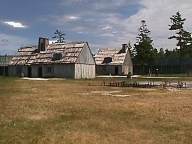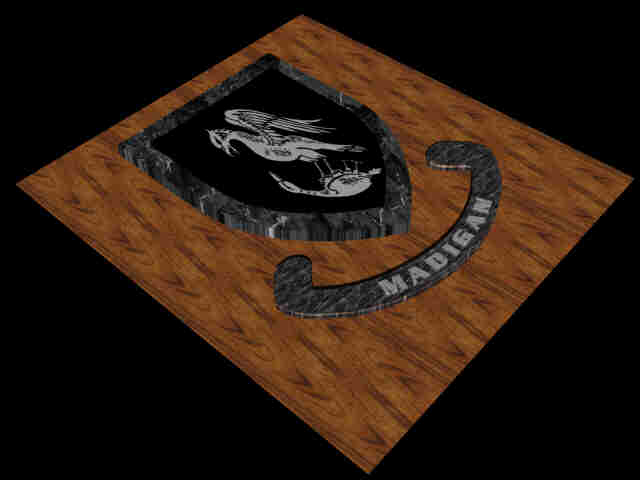The Forts of
the Mackinac Part I
Fort
Michilimackinac
Mackinaw
City, MI
June 5th, 2000
As we delved into the history of northern Michigan
and later along both shores of the Great Lakes, we would be
remiss in not introducing the single outstanding cause for all
that transpired here, in the 1700s and 1800s. Surprisingly,
European expansion into the Great Lakes area, was not the exalted
plan of some great political architect, building a new land for
the Europeans, nor was it the result of fierce military
adventurism brought on by aggressive generals. No, none of these
things created the peak interest Europe found in this new land
built up around the Great Lakes. It was a lowly rodent. That's
right, a rodent. Not withstanding that it was a very large rodent
by rodent standards, all the same it was in fact, the
unobtrusive, quiet, non-aggressive, but fashionable beaver that
delved into the history of northern Michigan
and later along both shores of the Great Lakes, we would be
remiss in not introducing the single outstanding cause for all
that transpired here, in the 1700s and 1800s. Surprisingly,
European expansion into the Great Lakes area, was not the exalted
plan of some great political architect, building a new land for
the Europeans, nor was it the result of fierce military
adventurism brought on by aggressive generals. No, none of these
things created the peak interest Europe found in this new land
built up around the Great Lakes. It was a lowly rodent. That's
right, a rodent. Not withstanding that it was a very large rodent
by rodent standards, all the same it was in fact, the
unobtrusive, quiet, non-aggressive, but fashionable beaver that  caused
thousands of Europeans to flock to the shores and surrounding
ponds and lakes to buy from the local Indians, all the beaver
skins that could be purchased. And fashionable he was, after
being skinned and dried, with his outer ruff fur removed to
expose an almost felt-like inner fur which was all the rage in
top hats throughout northern and central Europe. It was said that
no proper man would step out on the street without his top hat,
and beaver skin was the desired material, and of course a correct
man would have a hat that matched the rest of his fine apparel
and as such, several beaver hats would be required. It was the
market driven by this insatiable desire that drove the fur
trading industry
caused
thousands of Europeans to flock to the shores and surrounding
ponds and lakes to buy from the local Indians, all the beaver
skins that could be purchased. And fashionable he was, after
being skinned and dried, with his outer ruff fur removed to
expose an almost felt-like inner fur which was all the rage in
top hats throughout northern and central Europe. It was said that
no proper man would step out on the street without his top hat,
and beaver skin was the desired material, and of course a correct
man would have a hat that matched the rest of his fine apparel
and as such, several beaver hats would be required. It was the
market driven by this insatiable desire that drove the fur
trading industry  of the Great Lakes area. First exploited by the
French, then the British and finally the Americans this lowly
animal was hunted to near extinction for that fabulous fashion
statement that the men of that time had to have. The trade was
never interrupted, as it withstood famine, disease, and war, with
land often changing hands between countries. However, the lowly
beaver was never far from the drying rack. The first to explore
and reap the benefits of the lake shore area were the French, and
with them came the Army to see that the trade routes were kept
open and products continued to flow. Thus in 1715, Fort
Michilimackinac was built at what is now Mackinaw City, MI.
Primarily a trading post, Fort Michilimackinac was none the less
a military fort with its
of the Great Lakes area. First exploited by the
French, then the British and finally the Americans this lowly
animal was hunted to near extinction for that fabulous fashion
statement that the men of that time had to have. The trade was
never interrupted, as it withstood famine, disease, and war, with
land often changing hands between countries. However, the lowly
beaver was never far from the drying rack. The first to explore
and reap the benefits of the lake shore area were the French, and
with them came the Army to see that the trade routes were kept
open and products continued to flow. Thus in 1715, Fort
Michilimackinac was built at what is now Mackinaw City, MI.
Primarily a trading post, Fort Michilimackinac was none the less
a military fort with its  detachment of infantry lead by a Post
Commandant. In fact, throughout the French (1715-1761) and
British (1761-1781) regimes, the Post Commandant implemented
imperial policy at Michilimackinac and the upper Great lakes. He
regulated fur trading activities, negotiated with Indian nations,
and organized war parties of regular troops, militia, and Indians
to fight on distant battlefields. Among other duties, the Post
Commandant was required to keep detailed notes of the daily
activity of his men, the fort and the surrounding area. Some
commandants were quite efficient such as Major Arent Schuyler De
Peyster of the King's Eighth Regiment of Foot and his wife
Rebecca, who accepted the post in 1774.
detachment of infantry lead by a Post
Commandant. In fact, throughout the French (1715-1761) and
British (1761-1781) regimes, the Post Commandant implemented
imperial policy at Michilimackinac and the upper Great lakes. He
regulated fur trading activities, negotiated with Indian nations,
and organized war parties of regular troops, militia, and Indians
to fight on distant battlefields. Among other duties, the Post
Commandant was required to keep detailed notes of the daily
activity of his men, the fort and the surrounding area. Some
commandants were quite efficient such as Major Arent Schuyler De
Peyster of the King's Eighth Regiment of Foot and his wife
Rebecca, who accepted the post in 1774. Major De Peyster's even disposition and fair
treatment of people won him the respect of traders, Indian
Chiefs, and soldiers. A vivacious woman, Mrs. De Peyster oversaw
her household, entertained trader's wives and served as the
leading woman in the community. The French, understanding what
was necessary for a lasting relationship with the Ojibwa
(Chipewa) built a barter system in which only Indians could trade
pelts. This eliminated the white man's corruption and resulted in
the steady stream of furs out of the lake area. This was lost on
the British who failed to treat the Indians in a similar manner
resulting in the Fort being lost in battle. Upon returning, the
British being driven by the vast profits to be made, incorporated
many of the French ideas in running the fort as well as the
utilization of the French traders who had remained.
Major De Peyster's even disposition and fair
treatment of people won him the respect of traders, Indian
Chiefs, and soldiers. A vivacious woman, Mrs. De Peyster oversaw
her household, entertained trader's wives and served as the
leading woman in the community. The French, understanding what
was necessary for a lasting relationship with the Ojibwa
(Chipewa) built a barter system in which only Indians could trade
pelts. This eliminated the white man's corruption and resulted in
the steady stream of furs out of the lake area. This was lost on
the British who failed to treat the Indians in a similar manner
resulting in the Fort being lost in battle. Upon returning, the
British being driven by the vast profits to be made, incorporated
many of the French ideas in running the fort as well as the
utilization of the French traders who had remained.
